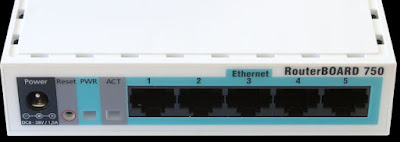The definition of the Product Code on a Mikrotik RouterBoard
Product code on Mikrotik has a meaning all its own. Sometimes we don't understand as to what the intent of the meaning of the name of the product code onMikrotik. Mikrotik Product Code but is very important to know if we wanted to purchase a Mikrotik devices.
 |
| RouterBOARD 750 |
Example Product Code Mikrotik RB750, RB751Ui-2HnD, RB951G-2HnD, RB912UAG-2HPND, RB2011UiAS-IN, CCR1009-8 g-1S-1S + CRS226-24G-2S + RM, etc.
From the example of the mikrotik product code we can know the type, the type, specification and device installation. How do I know the meaning of Mikrotik product code?
Let's discuss about product mikrotik.
Mikrotik RouterBoard on naming already standardised, with format as follows:
<board name> <board features>-<built-in wireless> <wireless card features>-<connector type>-<enclosure type>
The following is a description of each parameter:
The Board Name (Name Of Board)
As an example:
RB750
RB = RouterBoard7 = Shows the name of the series (700 series)
5 = indicates the number of the cable interface (ethernet, SFP, SFP +)
0 = indicates the number of wireless interface (mini PCI)
So the point of the product is, the RB750 RouterBoard series 700, which have 5 create ethernet interface and does not have a wireless interface.
Board Features (Features Board)
The features of this board is written directly after the name of the board without pause space or sign of the strip. The following features are on board product code: Mikrotik
U-USB
P-power injection with the controller (PoE out)
I-single port power injector without controllers (single PoE out)
A-more memory (and usually higher license levels)
H-more powerful CPU
G-Gigabit (probably including the "U", "A", "H", if not used with "L")
L-light Edition (lightweight)
S-Port SFP
e-PCIe interface card Extension
x <N> — where N is the number of CPU cores (x 2, x 16, x36 etc.)
R-Slot MiniPCI or MINIPCIe
Built-in Wireless (Wireless Provisioning)
If its already Mikrotik boards provided with the default wireless interface, the following naming format:<band><power_per_chain><protocol><number_of_chains>
Here's a description of each parameter:
band
5 = 5 GHz
2 = 2.4 Ghz
52 = dual band 5 GHz and 2.4 Ghz
power per chain
(Blank) = "Normal"-6Mbps at 23dBm < 802 .11A; 24dBm at 6Mbps < 802.11 g
H = "High"-23-24dBm at 6Mbps 802 .11A; 24-27dBm at 6Mbps 802.11 g
HP = "High Power"-25-26dBm 6Mbps 802 .11A; 28-29dBm at 6Mbps 802.11 g
SHP = "Super High Power"-+ 27 dBm at 6Mbps 802 .11A; + 30 dBm at 6Mbps 802.11 g
Protocol
(blank) = Card with standard 802.11 a/b/g
n = Card 802 .11n support
AC = Card 802.11 support air conditioning
number_of_chains
(blank) = single chain
D = dual chain
T = triple chain
connector type
(blank) = only one connector option only
MMCX connectors MMCX type =
u. FL = to type connectors u. FL
Enclosure Type (The Type Of The Container/Chassis)
The following describes the type of the container/casing on Mikrotik products code:BU = board units (without casing)
RM = rack-mount enclosure (Casing which is devoted to in place on rack with mounting)
In-indoor enclosure (Casing used to put on indoor without rack mounting)
Em-the extended memory (larger memory capacity)
LM-light memory (smaller memory capacity)
Be-black edition case (Casing with Special Edition color black)
TC-Tower (vertical) case (Chassis type tower stands)
OUT-outdoor enclosure (Special Casing for installation outdoors)
That's some of the discussion about miktorik products with features and the like, may be beneficial.
Comments